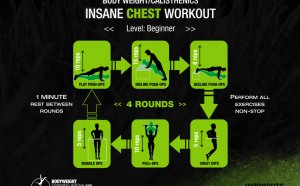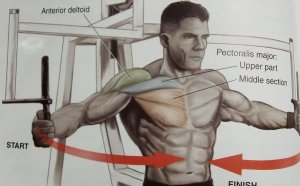
Mass Building chest Workout
 Let me guess: Your chest routine consists of four sets of flat bench, incline dumbbell presses, and flat flyes. If so, well, you have plenty of company. It's the same Monday program countless lifters have been following for years without modification. And that's because it works—to a point.
Let me guess: Your chest routine consists of four sets of flat bench, incline dumbbell presses, and flat flyes. If so, well, you have plenty of company. It's the same Monday program countless lifters have been following for years without modification. And that's because it works—to a point.
If you've hit a training plateau, or if you just can't remember the last time you shook things up, consider bringing some new stimuli into your chest training. Working the chest muscles with a variety of exercises and angles is the best approach, and these five movements do the job and then some.
Chest Structure and Function
Your chest is composed of two muscle groups: the large pectoralis major, and the smaller pectoralis minor underneath. The flat, thick pec major originates in a broad sweep along the anterior surface of the clavicle, down the sternum, and from the cartilage of the ribs. It inserts into a much smaller area, the intertubular groove at the top of the humerus (upper arm).
 The narrow, triangular pec minor originates from the upper and outer surfaces of three ribs and inserts into the coracoid process, a bony protrusion next to the shoulder joint.
The narrow, triangular pec minor originates from the upper and outer surfaces of three ribs and inserts into the coracoid process, a bony protrusion next to the shoulder joint.
The pec major is responsible for a number of actions involving the humerus, such as lifting the arm from the side (adduction), from the front (flexion), or turning it in an arm-wrestling motion (internal rotation). The pec minor has one major function, which is to stabilize the scapula.
The most popular exercises to add resistance to these basic movements include the bench press, dumbbell press, dumbbell flye, cable crossover, and the push-up. But they're by no means the only options. Let's take chest training a step farther and look at more advanced techniques to shock your muscles into growth.
180-Degree Twisting Dumbbell Bench Press
If you're like me and have suffered a torn pec while benching, you'll agree that the barbell bench press is not ideal for everyone. I also find that my shoulders take over when I'm doing the flat and incline bench, so I prefer to use the dumbbell chest press instead.
But I don't just do any chest press. I add a twist—literally—in order to utilize the benefits of a supine or reverse grip. A study performed in my home town of Toronto determined that when subjects used a supinated grip during an isometric hold of the flat bench press, it resulted in increased activity for the upper portion of the pectoralis major as compared to a regular pronated grip.1
180-Degree Twisting Dumbbell Bench Press
- Lie back on a bench holding two dumbbells with a standard grip (palms forward) and arms extended over your chest.
- Slowly lower the dumbbells to your outer chest, then press and rotate 180 degrees as you push back up to starting position. You should have a supine grip with your pinkies inward and palms facing your face at the top of the movement. Hold this peak contraction for 2 seconds before lowering into the next rep.
- Keep your shoulders back and down during the press to maximize pec involvement and minimize delt takeover.
Close-Grip Weighted Push-up
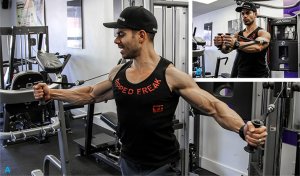 The push-up is a great exercise, but you have to do it a certain way in order to maximize chest activity. Try using the close-grip weighted push-up as a finishing move after you're done trashing your chest with the weights. The narrow hand position brings out the inner pecs and the added weight across the back elevates this from an everyday move to a pec destroyer.
The push-up is a great exercise, but you have to do it a certain way in order to maximize chest activity. Try using the close-grip weighted push-up as a finishing move after you're done trashing your chest with the weights. The narrow hand position brings out the inner pecs and the added weight across the back elevates this from an everyday move to a pec destroyer.
Back in 2005, researchers at the Mayo Clinic tested 11 men and 29 women to determine the effect of three different hand positions when performing the push-up: shoulder-width, wider, and narrower. The study showed the EMG activity in the pectoralis major was greatest during push-ups with a narrow hand position.2
Close-Grip Weighted Push-up
- Start in a push-up position with your hands about six inches apart. Add resistance by wearing a weighted vest or have a training partner place a weight or sandbag on your back.
- Slowly lower your chest to the ground and press back up until you fully extend your elbows.
Cable Crossover 21s
Cable work is a great addition to free weights. It provides constant tension throughout the range of motion. But can it match the same level of muscle activation? Perhaps so, according to a recent study sponsored by the American Council on Exercise that investigated the EMG activity of nine common chest exercises.3 A team of researchers from the University of Wisconsin found that the bent-forward cable crossover produced nearly the same pectoralis major stimulation as the barbell bench press, which was rated the highest.
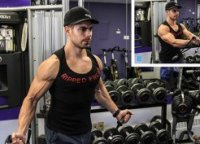



INTERESTING VIDEO
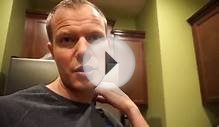
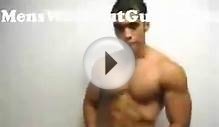

Share this Post
Related posts
No equipment Chest Workout
Steps Method 1 Doing Pushups Perform basic pushups. There are many variations of pushups that can help you build your chest…
Read MoreChest Workout for definition
Has never been complex, he always focused on the basics. So if you want to get a big chest, we prepared you a workout inspired…
Read More